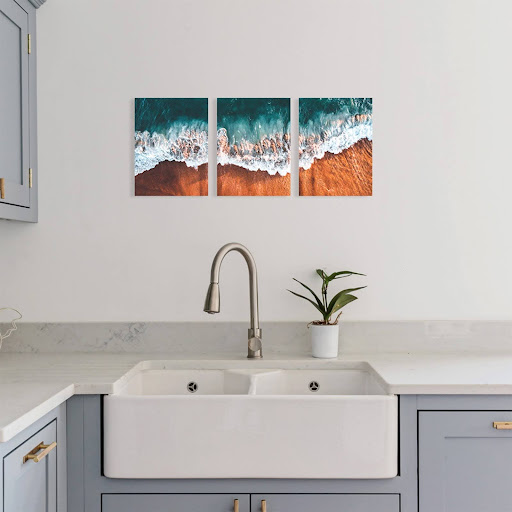You walk into those perfectly styled homes on Instagram and wonder: “How do they make every room look so effortlessly put together?”
The secret isn’t expensive furniture or perfect lighting. It’s something most homeowners completely overlook: strategic wall art decor placement that follows proven design principles.
After studying thousands of magazine-worthy homes, interior designers have discovered specific wall art for every room styling tips for your home that create instant visual impact. These aren’t random decoration ideas – they’re psychological triggers that make spaces feel intentionally designed, expensive, and deeply personal.
The Psychology Behind Rooms That “Feel Right”
Decorative wall art doesn’t just fill empty spaces. It creates emotional anchors that make rooms feel complete and welcoming. When you understand how to choose wall art for living room spaces and beyond, you’re not just decorating – you’re crafting experiences.
The difference between homes that feel chaotic and those that feel intentionally curated comes down to understanding three core principles that interior designers guard closely:
- Visual weight distribution that creates natural flow
- Color psychology that influences mood and behavior
- Scale relationships that make spaces feel proportional and comfortable
These wall decoration ideas for the living room and other spaces work because they tap into how our brains process visual information. When done correctly, your guests won’t know why your home feels so appealing – they’ll just know it does.
Room-by-Room Art Selection Mastery
How to Choose Wall Art for Living Room Spaces That Command Attention
Your living room serves as your home’s social headquarters. Wall decor art in this space needs to create conversation while reflecting your personality without overwhelming the furniture or competing for attention.
The 2/3 Rule for Wall Art states that your decorative wall art should measure approximately two-thirds the width of the furniture beneath it. This creates visual harmony that feels naturally balanced rather than accidentally placed.
For sofas measuring 84 inches wide, your wall art decor should span roughly 56 inches. Achieve this with a single statement piece or multiple coordinated works arranged as a collection.
Living room success strategies:
- Position larger pieces above your primary seating area
- Choose colors that either complement or thoughtfully contrast your existing palette
- Consider Fracture’s XXL Feature Size glass prints that create dramatic focal points
- Mix textures by combining photography with abstract pieces
Wall decoration ideas for the living room work best when they reflect the room’s energy level. Social spaces benefit from more vibrant, engaging pieces, while quiet conversation areas call for calmer, more contemplative artwork.
How to Choose Wall Art for Bedroom Spaces That Promote Rest
Bedroom wall decor art serves a completely different psychological purpose than social spaces. These intimate areas require pieces that promote relaxation while reflecting your personal style preferences.
Bedroom-specific considerations:
- Select calming color palettes that support sleep quality
- Choose subjects that create positive emotional associations
- Avoid overly stimulating or busy patterns near the bed
- Consider personal photography printed on premium glass for intimate, meaningful displays
The area above your headboard offers prime real estate for a statement piece or carefully curated collection. Avoid placing busy or chaotic imagery where you’ll see it while trying to fall asleep.
Unique wall art ideas for bedrooms include nature photography, abstract pieces in soft tones, or personal travel images that evoke positive memories and experiences.
Kitchen and Dining Wall Decoration Ideas at Home
Kitchen decorative wall art must withstand humidity, temperature changes, and cooking vapors while adding personality to utilitarian spaces. Choose moisture-resistant materials and subjects that enhance rather than compete with food preparation activities.
Kitchen art strategies:
- Food photography and botanical prints create thematic coherence
- Vintage advertisements add character without overwhelming
- Gallery wall collections work well in larger kitchen spaces
- Consider smaller art prints for compact galley kitchens
Dining rooms accommodate more formal pieces that enhance the eating experience. These spaces allow for bolder choices since they’re used primarily for specific activities rather than constant daily living.
The 3-5-7 Rule in Decorating (Professional Secret)
What is the 3-5-7 rule in decorating? This professional guideline suggests using odd numbers of elements in groupings because they create more dynamic, natural-looking arrangements than even numbers.
Practical applications:
- Group 3 pieces instead of 2 or 4
- Arrange 5 items on a shelf rather than 6
- Create gallery walls with 7 or 9 pieces for visual interest
- Use odd numbers even for decorative objects around artwork
This principle works because odd numbers prevent our eyes from pairing items symmetrically, creating more movement and visual engagement throughout the space.
Size, Scale, and Placement Secrets
Canvas wall art impact depends heavily on proper sizing and placement. Small pieces disappear on large walls, while oversized art overwhelms intimate spaces.
Professional sizing guidelines:
- Measure wall space and existing furniture before shopping
- Leave 6-8 inches between furniture tops and artwork bottoms
- Hang pieces so centers sit 57-60 inches from the floor
- For high ceilings, adjust height slightly upward to maintain proportion
How to style art in your home effectively requires understanding that visual weight matters as much as physical dimensions. Dark, busy pieces carry more visual weight than light, simple ones.
Advanced placement techniques:
- Balance heavy pieces with multiple lighter elements on opposite sides
- Use the largest piece as an anchor point in multi-piece arrangements
- Maintain consistent spacing between grouped pieces (typically 2-3 inches)
- Plan layouts on the floor before committing to wall placement
Color Coordination That Actually Works
Wall art decor doesn’t need to match your room colors exactly – it should enhance them. Understanding color relationships prevents clashing while creating sophisticated, intentional-looking spaces.
Professional color strategies:
- Choose pieces containing colors found elsewhere in your space
- Use neutral art prints in rooms with bold color schemes
- Introduce new colors through artwork in otherwise neutral spaces
- Consider how natural and artificial lighting affects color perception
How to coordinate art in a room successfully means looking beyond exact color matches to consider undertones, saturation levels, and how colors interact with your lighting throughout the day.
For rooms with existing strong color commitments, curated art collections take the guesswork out of color coordination by featuring professionally selected pieces designed to work together harmoniously.
Creating Gallery Walls That Don’t Look Amateur
Gallery walls represent advanced wall decoration ideas at home that, when executed correctly, create stunning focal points. When done poorly, they look cluttered and chaotic.
Professional gallery wall process:
- Cut paper templates matching your frame sizes
- Experiment with arrangements on the floor first
- Start with your largest piece as the central anchor
- Build outward with smaller supporting pieces
- Maintain consistent spacing throughout
- Mix sizes significantly rather than using similar dimensions
What mistakes to avoid:
- Grids have their place – but vary sizes and positions for max impact
- Avoid hanging everything at the same height
- Don’t use too many different frame styles (limit to 2-3 maximum)
- Never start hanging without planning the complete layout first
Unique wall art ideas for gallery walls include mixing mediums – combine photography, illustrations, and textural elements while maintaining color or thematic consistency.
Photo Display Ideas That Break Traditional Rules
Moving beyond traditional framing opens creative possibilities while reducing costs and installation complexity. These photo display ideas work particularly well with high-quality prints that can stand alone as art pieces.
Professional display techniques:
- Clip systems using matching hardware create casual yet modern presentations
- Picture ledges allow easy rearrangement and layering of different sizes
- Wire and string displays add movement and flexibility to photo arrangements
- Tape applications with archival materials create floating effects
These methods work exceptionally well with glass prints because of their longevity while their vibrant colors maintain impact without frame enhancement.
Advanced display strategies:
- Layer multiple sizes on ledges for dimensional interest
- Use consistent clip finishes throughout rooms for visual continuity
- Create geometric patterns with string or wire installations
- Mix framed and unframed pieces for textural variety
Lighting That Makes Framed Wall Art Look Expensive
Even the most carefully chosen framed wall art falls flat without proper lighting consideration. Professional-quality lighting transforms good pieces into stunning focal points while protecting your investment from damage.
Natural light strategies:
- Position artwork/natural lighting for the most ambient/bright look
- Consider how lighting changes throughout the day affect color perception
- Use north-facing walls for consistent, gentle lighting
- Avoid south-facing positions that create harsh shadows and fading as it only applies to traditional frames and not Fracture made frames.
Artificial lighting enhancements:
- Picture lights create gallery-quality illumination for statement pieces
- Track lighting offers flexibility for multiple pieces or changing displays
- LED strips behind larger works create modern floating effects
- Strategic lamp placement can highlight artwork without dedicated fixtures
Budget-Smart Art Selection That Looks High-End
Creating impressive wall art decor doesn’t require substantial financial investment when you focus resources strategically and understand where to prioritize spending.
Professional budget strategies:
- Invest in one or two statement pieces per room rather than many mediocre ones
- Mix high-quality prints with more affordable supporting pieces
- Consider digital downloads printed on premium materials
- Use creative display methods that eliminate expensive custom framing
How to choose artwork for your home on a budget means prioritizing pieces that create maximum impact. One large glass print often provides more visual presence than multiple smaller conventional prints.
Cost-effective quality indicators:
- High-resolution printing maintains detail at larger sizes
- Quality materials resist fading and environmental damage
- Professional printing services ensure color accuracy and consistency
- Durable substrates handle repositioning without damage
How to Style a Room with Art (Step-by-Step Process)
How to style a room with art effectively requires a systematic approach that considers the room’s function, existing decor, and desired atmosphere.
Professional styling sequence:
- Assess your space – measure walls, note furniture placement, evaluate lighting
- Define your style – identify consistent themes, colors, or subjects that appeal to you
- Plan your layout – use templates to experiment before making commitments
- Start with anchor pieces – establish focal points with your largest or most impactful works
- Build supporting displays – add smaller pieces that enhance rather than compete
- Evaluate and adjust – step back frequently to assess overall composition and balance
Common styling mistakes to avoid:
- Rushing the selection process without considering long-term satisfaction
- Ignoring the room’s function when choosing subjects or energy levels
- Forgetting to account for furniture and decor changes over time
- Underestimating the impact of proper lighting on artwork appearance
Advanced Techniques for Unique Wall Art Ideas
Unique wall art ideas often emerge from thinking beyond traditional approaches and considering how different elements interact to create cohesive but unexpected presentations.
Professional advanced strategies:
- Seasonal rotation systems that keep spaces feeling fresh
- Themed collections that tell stories about your interests, experiences, or values
- Mixed media combinations that add texture and dimensional interest
- Personal photography integration that creates custom art no one else will have
How to choose art for my room when seeking unique solutions means considering your lifestyle, interests, and the stories you want your space to tell about who you are.
Creating custom solutions:
- Transform personal photography into professional-quality displays
- Combine multiple related images into gallery wall arrangements
- Use consistent printing methods to unify disparate image sources
- Consider how personal pieces interact with purchased artwork
Frequently Asked Questions
Question : How do I ensure my art choices will still look good in five years?
Answer : Choose pieces based on personal connection rather than trends. Quality printing on durable materials like glass maintains appearance over time, while timeless subjects and classic compositions resist dated appearances.
Question : What’s the biggest mistake people make when selecting wall art?
Answer : Choosing pieces too small for their spaces. When in doubt, go larger rather than smaller. A single substantial piece creates more impact than multiple tiny ones scattered across a large wall.
Question : How many pieces should I put in a gallery wall?
Answer : Use odd numbers (3, 5, 7, 9) for more dynamic arrangements. Start with fewer pieces and add over time rather than overwhelming the space initially. Quality curation beats quantity every time.
Question : Should all my wall art match throughout my home?
Answer : Create connections through color, style, or subject matter without making everything identical. Each room should maintain its personality while contributing to your home’s overall aesthetic story.
Question : How do I know if my art arrangement looks professional?
Answer : Step back and observe how your eyes move through the space. Professional arrangements guide attention naturally without creating visual confusion or competition between elements.
Transform Your Home Today
Wall art for every room styling tips for your home work when they’re applied systematically with attention to scale, color, and placement principles that professional designers use consistently.
The difference between homes that feel accidentally decorated and those that appear intentionally curated lies in understanding these proven techniques and applying them thoughtfully throughout your space.
Your walls represent untapped potential waiting to tell your story. With quality pieces and strategic placement, every room becomes an opportunity to create spaces that inspire, comfort, and impress everyone who enters.
Ready to transform your space with artwork that commands attention? Start with premium glass prints that deliver the color vibrancy and durability these professional techniques deserve.
Your walls—and your guests—will notice the difference immediately.





Comments